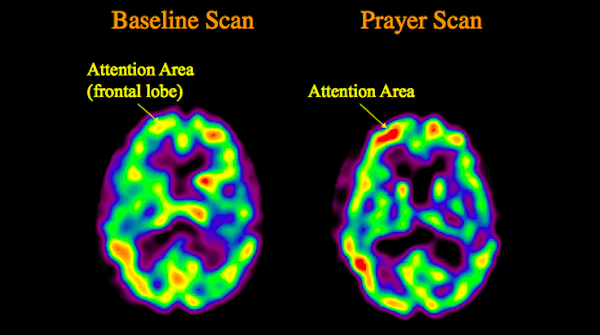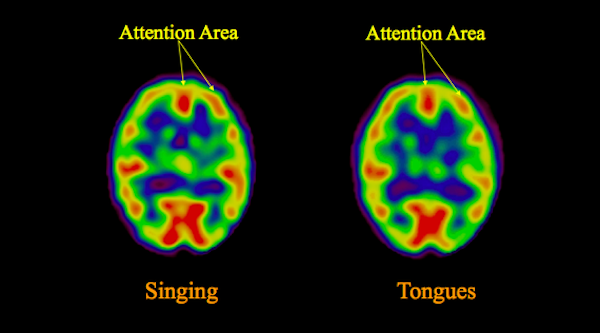
"Everyone philosophizes," writes neuroscientist Dr. Andrew Newberg in his latest book, The Metaphysical Mind: Probing the Biology of Philosophical Thought. We all speculate about the meaning of all kinds of things, from everyday concerns about dealing with a co-worker to our ultimate beliefs about the purpose of existence. Accompanying solutions we find to these problems, there's a range of satisfied feelings, from "ah-ha" or light-bulb moments upon solving an everyday problem to ecstatic feelings during mystical experiences.
Since everyday and spiritual concerns are variations of the same thinking processes, Newberg thinks it's essential to examine how people experience spirituality in order to fully understand how their brains work. Looking at the bigger questions has already provided practical applications for improving mental and physical health.
Newberg is a pioneer in the field of neurotheology, the neurological study of religious and spiritual experiences. In the 1990s, he began his work in the field by scanning what happens in people's brains when they meditate, because it is a spiritual practice that is relatively easy to monitor.
Since then, he's looked at around 150 brain scans, including those of Buddhists, nuns, atheists, Pentecostals speaking in tongues, and Brazilian mediums practicing psychography-the channeling of messages from the dead through handwriting.
As to what's going on in their brains, Newberg says, "It depends to some degree on what the practice is." Practices that involve concentrating on something over and over again, either through prayer or a mantra-based meditation, tend to activate the frontal lobes, the areas chiefly responsible for directing attention, modulating behavior, and expressing language.
In contrast, when practitioners surrender their will, such as when they speak in tongues or function as a medium, activity decreases in their frontal lobes and increases in their thalamus, the tiny brain structure that regulates the flow of incoming sensory information to many parts of the brain. This suggests that their speech is being generated from some place other than the normal speech centers.
Believers could say this proves that another entity is speaking through the practitioner, while nonbelievers would look for a neurological explanation. Newberg takes into account both perspectives. When he defines neurotheology in his book, Principles of Neurotheology, he writes, "An ardent atheist, who refuses to accept any aspect of religion as possibly correct or useful, or a devout religious person, who refuses to accept science as providing any value regarding knowledge of the world, would most likely not be considered a neurotheologian."
Newberg believes everyone can benefit from some type of meditation practice. If one practice isn't working for an individual, she should try something else. As a general rule, these practices lower depression, anxiety, and stress. He adds that at Thomas Jefferson University in Philadelphia, where he is director of research at the Myrna Brind Center of Integrative Medicine, researchers have found that meditation can improve memory and concentration.
It's debatable whether these practices are more effective when founded on religious or spiritual beliefs. Dr. Dean Hamer, author of the book, The God Gene: How Faith is Hardwired into our Genes, discovered that research subjects with a particular variation of a certain gene were more susceptible to self-transcendent, spiritual experiences.
In a lecture given at Marlboro College titled, "Gays, God, and Genes," Hamer compares the effects of this variation to an enhanced capacity for natural highs. This spiritual tendency also depends on a person's environment, according to Hamer, which can direct their innate spirituality to particular religious beliefs, and/or steer them away from religion altogether. He says that science will never replace spirituality because a reliance on facts will never have the same emotional appeal.
Newberg agrees that spiritual beliefs are influenced by a person's genetics and environment, and that meditation practices are more effective when they reinforce a practitioner's belief system. However, he says researchers are still investigating whether religious beliefs in general make healthier and happier people. He considers atheism to be a belief system as well, and says that a possible mental health benefit of belonging to a religious denomination could be not just belief, but the built-in social network.
If the euphoria a person experiences during a meditation practice can't be integrated into their preexisting belief system, these feelings may become disturbing. Newberg gave as an example a meditator who sought out a clergy member to talk about his practice and felt a bit brushed off by the cleric. When meditation practices enhance a rigid, authoritarian belief system, Newberg said they can lead to more intolerance and violence towards those of different beliefs. In the book he co-authored with Mark Robert Waldman, Why We Believe What We Believe, he writes that due to some overlap between spiritual beliefs and psychological disorders, patients with obsessive compulsive disorders often develop rigid religious beliefs.
Newberg had always wanted to be a medical doctor, but didn't realize he could combine that with his interest in searching for answers to metaphysical questions until he attended medical school at the University of Pennsylvania and worked with Dr. Eugene d'Aquili, a psychiatrist whose research focused on religion.
Newberg has studied Eastern and Western thinkers to understand their differing perspectives on whether or not an objective reality exists outside of human perception. What fascinates him about mystical experiences-the goal of many meditation practices-are the reports of experiencing a higher reality that is "more real" than everyday perceptions.
Newberg said it's "the only description that I've ever seen where somebody will say 'I got beyond my brain, I got beyond my ego self, I got beyond the subjective and objective nature of the world;' and then they see the universe, and they experience the universe in a very, very different kind of way."
He added, "I think these experiences need to be taken very seriously. I think they tell us something about the nature of reality and how we perceive that reality."
When Newberg scanned the brains of nuns and Buddhists undergoing mystical experiences, they reported feelings of timelessness, spacelessness, and self-transcendence. Newberg believes a cause of these feelings is the reduced activity he saw in their parietal lobes, the orientation area of the brain responsible for perceiving three-dimensional objects in space. A meditator may experience a sense of oneness with all living things or unity because the reduced activity blurs the perceived lines between the meditator and other objects.
When the parietal lobes are damaged, patients have distorted beliefs about their own bodies and are sometimes confused about their spatial orientation to outside objects. In an example from Why We Believe What We Believe, patients think one of their own legs is not theirs, and have been found trying to throw this other leg out of their bed. In his new book, Newberg cites a study led by Dr. Brick Johnstone that found that damage to the right parietal lobe caused patients' self-transcendent experiences to increase.
Newberg suggests in his new book that mystical experiences are described as blissful or ecstatic because they share many of the same neural pathways in the parietal and frontal lobes that are involved in sexual arousal.
To take his scans, Newburg uses functional magnetic resonance (fMRI), and single-photon emission computerized tomography (SPECT) imaging. The book Brainwashed: The Seductive Appeal of Mindless Neuroscience, lists their technological limitations. The authors, Drs. Sally Satel and Scott Lilienfeld, write that one limitation of brain imaging is that researchers can't make a neat map of the brain centers for different activities like phrenologists once did. Even if most people process language expression in one particular area, this processing is highly dependent on connections to other brain activities. The brain is also plastic, so if the usual area for speech is damaged, other areas in the brain may reorganize and take over the function.
While locating the appropriate brain centers, researchers must also break down the steps involved in a seemingly unified mental task. The authors provide a simple arithmetic problem as an example. Researchers must consider that one section of the brain enables a person to visually recognize the numbers, another section registers the magnitude of the numbers, and a third section computes the sum. If neuroscientists are trying to understand attitudes or emotions, they have to take into account more complicated steps. Furthermore, the technology isn't advanced enough to pick up all the rapid neural changes that occur during a mental process.
When e-mailed to comment specifically on Newberg's work, Satel responded that today's imaging is enabling researchers to make clinical inroads into dementia and other major mental illnesses, but she's skeptical that knowing a person's neurochemical and other physical processes will ever provide a detailed understanding of someone's subjective beliefs. Even with advances in technology, "we can't predict the real world contexts in which perceptions, cognitions, or emotion will manifest. The interaction of these dimensions with environment is crucial to understanding behavioral outcomes."
Asked about the technological challenges, Newberg said that "it's not easy doing this research." However, "up until the last 20 years, we've never been able to see anything. So it's certainly a vast improvement over nothing, but it's still not nearly as ideal as what we would like."
Supplementing the scans, Newberg and his team interview meditators about their subjective experiences in order to get a better understanding of what is happening to them physically. For this method, a challenge has been figuring out precisely what interviewees mean when they use concepts like God or spirituality. Newberg has found that everyone defines God a little bit differently even when they belong to the same religion. When describing spiritual experiences, some report that these experiences enhance their religious beliefs, and others turn away from religion and engage in individual practices.
Given the challenges of the technology and the multitude of beliefs and practices, I asked Newberg if he ever gets overwhelmed.
"It's a little overwhelming. You sort of take one thing at a time and just proceed slowly, and I try very hard not to get too far ahead of myself or too ahead of the data," he said. "But I guess it's somewhat of a calling for me. I've always felt like I've got to go down this path, and I'll keep going down it, and maybe someday I'll figure something out that will really be helpful to everybody."





Reader Comments